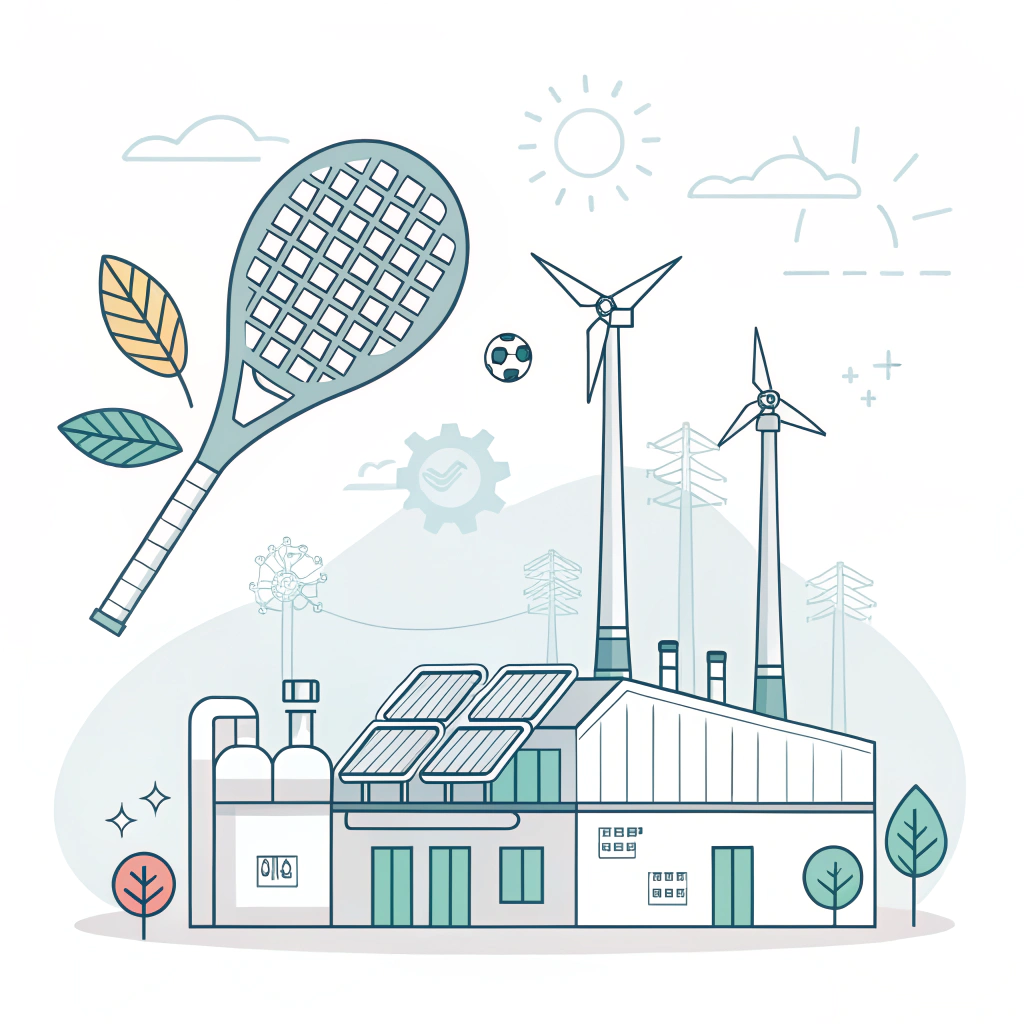The environmental impact of padel racket production is significant—but with advanced, eco-friendly techniques, manufacturers can optimize performance while reducing carbon footprints. In this article, we explore how sustainable production methods, including the use of carbon fiber1 and recycled materials, help improve padel racket manufacturing practices and support global sustainability goals.
As the sports equipment market grows, manufacturers face increasing pressure to reduce their environmental impact. Companies, especially those in the B2B arena like procurement executives and sustainability managers, are seeking partners that combine high-performance production with green manufacturing processes. For example, padel rackets need to deliver optimal power and control, yet the manufacturing process must also minimize energy consumption, material waste, and emissions. NEX Padel has committed to eco-friendly production by integrating renewable energy sources, efficient production techniques, and comprehensive life cycle assessments.
One of the most critical decisions in padel racket manufacturing is the choice between carbon fiber1 and fiberglass. Each material has distinct performance benefits as well as environmental considerations.
A key advantage of carbon fiber is its ability to provide greater power and control compared to fiberglass. Carbon fiber's rigidity means it absorbs less force during play, contributing to a more responsive and durable racket. However, this high performance often comes at a higher environmental cost in terms of energy usage during production.
Fiberglass, on the other hand, tends to be less expensive and requires lower energy during manufacture, making it an attractive option for entry-level rackets. Yet, it may not offer the same long-term durability as carbon fiber, potentially leading to more frequent replacements and increased waste over time.
Below is a comparative table showing some of the key aspects that manufacturers consider when balancing performance with sustainability:
| Factor | Carbon Fiber | Fiberglass |
|---|---|---|
| Performance | Superior power and control | Adequate for beginners; less power/control |
| Production Energy Consumption | Higher due to advanced curing processes | Lower thermal processes involved |
| Environmental Impact | Potentially higher carbon footprint | Lower immediate footprint but potential durability issues may increase waste |
| Durability | Longer lifespan, which can offset environmental costs over time | May require more frequent replacement |
| Cost | Higher production cost | More cost-effective for lower-end products |
This balance between performance and environmental impact is crucial, as sustainability managers need suppliers who not only deliver quality products but also align with eco-friendly values.
Sustainable padel racket manufacturing extends beyond material selection. Manufacturers like NEX Padel incorporate advanced production techniques that reduce waste and maximize energy efficiency throughout the production process.
Some key environmental practices include:
• Renewable Energy2 Utilization: Many facilities are switching to renewable energy sources such as solar or wind power, which significantly reduce CO₂ emissions from traditional manufacturing processes.
• Waste Minimization and Recycling: By implementing strict quality control measures, manufacturers can reduce scrap material. Additionally, recycling off-cuts and expired materials helps improve overall sustainability.
• Life Cycle Assessment3 (LCA): Conducting comprehensive LCAs ensures that every step—from raw material acquisition to end-of-life recycling—is designed to minimize environmental impacts.
• Supply Chain Transparency4: Detailed documentation and monitoring of suppliers' environmental credentials allow companies to verify their eco-friendly claims and ensure compliance with regulatory standards.
In our approach, we focus heavily on these aspects to support brands that prioritize environmental sustainability5. Expanding our sustainable practices not only improves our production efficiency but also substantially reduces the overall carbon footprint of the finished products.
For corporate decision-makers, partnering with a manufacturer that emphasizes total eco-friendly production provides several strategic advantages:
-
Regulatory Compliance: Worldwide regulations are becoming stricter regarding environmental pollution and energy use. Collaborating with manufacturers that have robust environmental practices can help your company meet these emerging standards.
-
Enhanced Brand Reputation: Customers increasingly expect companies to be socially and environmentally responsible. An eco-friendly supply chain often translates into higher customer loyalty and improved market positioning.
-
Cost Efficiency over Time: Although sustainable production may involve higher upfront costs, the long-term economic benefits include lower energy expenses, reduced waste, and extended product lifespans. This can ultimately lead to cost savings and a more resilient supply chain.
-
Risk Management: A transparent and sustainable supply chain reduces risks related to resource scarcity and regulatory penalties. This ensures stable production and reliability for sports equipment brands.
-
Innovation and Competitive Edge: Manufacturers adopting green technologies often lead the market innovation curve. This approach can facilitate novel product developments with improved performance while simultaneously reducing environmental impact.
A closer look at our practices at NEX Padel reveals how these strategic benefits translate into tangible results. Our rigorous testing and continuous improvement cycle ensure that every padel racket we produce not only meets high-performance standards but also adheres to strict environmental criteria. By continuously updating our methods—such as adopting full traceability in our sustainable production methods—we set a high benchmark for the industry.
Consider the following case study:
• A leading sports brand recently partnered with NEX Padel to supply their equipment, driven by the desire to reinforce their commitment to sustainability. Through a detailed life cycle assessment and rigorous testing of materials, we were able to demonstrate a significant reduction in energy consumption and material waste compared to traditional production methods. This partnership not only improved the brand’s eco-friendly credentials but also resulted in measurable cost savings over time.
For procurement executives and sustainability managers looking to integrate green manufacturing into their supply chain, here are some actionable recommendations:
• Conduct Detailed Supplier Audits: Ensure potential suppliers have clear documentation of their environmental practices. Look for certifications such as ISO 14001 or other sustainability awards that confirm their commitment.
• Prioritize Life Cycle Analysis: Engage with manufacturers that perform LCAs to monitor environmental impact at every production stage. This information can help predict long-term savings and environmental benefits.
• Evaluate Material Sources: When choosing between materials like carbon fiber and fiberglass, consider both performance benefits and environmental impacts. Conduct a cost-benefit analysis over the product lifecycle to determine which material best aligns with your sustainability goals.
• Incorporate Renewable Energy Solutions: Ask suppliers about their energy sources and their initiatives to transition to renewable energy. This directly correlates with lower operational emissions and a reduced carbon footprint.
• Implement Supplier Training Programs: Encourage suppliers with targeted training and workshops on sustainable manufacturing techniques. Investing in supplier education ensures continuous improvement in eco-friendly practices.
• Seek Transparency: Work only with partners who showcase clear supply chain transparency. Transparency builds trust and ensures that eco-friendly claims are backed by solid data.
Integrating eco-friendly manufacturing practices in padel racket production is a holistic process. By carefully balancing material performance with environmental stewardship, manufacturers like NEX Padel demonstrate that it is possible to achieve high performance without compromising sustainability. Procurement executives and sustainability managers can significantly benefit from partnering with manufacturers who invest in renewable energy, waste minimization, clear supply chain transparency, and comprehensive environmental certifications.
As global environmental standards become more stringent and consumer demand for sustainable products grows, green manufacturing is not just a trend—it is a strategic imperative. Companies that adapt to these changes position themselves for long-term success in an increasingly eco-conscious market.
By choosing a partner like NEX Padel, decision-makers are investing in cutting-edge production technologies that optimize the performance of sports equipment while meeting the highest environmental standards. This dual focus on performance and sustainability offers competitive advantages, risk mitigation, and positive brand impact.
• What does carbon do in a padel racket?
Carbon fiber in a padel racket raises the overall stiffness of the frame, resulting in enhanced power during quick shots and improved control. Its ability to maintain shape under stress means energy is transferred more efficiently to the ball.
• Do padel rackets get damaged in the rain?
Padel rackets can suffer from moisture exposure because water can seep into the core materials, accelerating deterioration. It is recommended to avoid playing in wet conditions to prevent premature wear and ensure the racket’s longevity.
• What material are padel rackets made of?
Padel rackets are primarily constructed from carbon fiber1 or fiberglass. While fiberglass is more affordable and common in entry-level models, carbon fiber is favored in intermediate and advanced rackets for its superior performance and durability.
-
Carbon Fiber: Click to read about how carbon fiber is used in padel racket manufacturing, including its performance benefits and the environmental considerations associated with its production. ↩ ↩ ↩2 ↩3
-
Renewable Energy: Click to understand how renewable energy sources like solar and wind are integrated into production processes, reducing emissions and lowering operational costs. ↩ ↩
-
Life Cycle Assessment: Click to explore how Life Cycle Assessments (LCAs) evaluate the environmental impact of manufacturing processes from raw material extraction to end-of-life disposal. ↩ ↩
-
Supply Chain Transparency: Click to learn about the role of clear supply chain documentation and monitoring in ensuring that manufacturers adhere to strict sustainability standards. ↩ ↩
-
Environmental Sustainability: Click to discover the strategies behind environmental sustainability in manufacturing, including benefits such as cost efficiency, risk mitigation, and enhanced brand reputation. ↩ ↩







